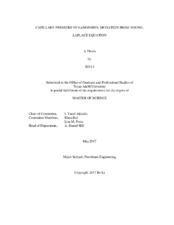| dc.description.abstract | Recent studies on multi-phase fluids in nanoscale capillaries indicated that the capillary wall-fluid interactions could play a dominant role on the co-existence of the phases, which caused the fundamental properties of the fluids, such as density, viscosity, and interfacial tension, to become capillary size-dependent. At the extreme of the confinement, these properties become vague. This raises a serious question on the validity of Young-Laplace equation to predict capillary pressure in small capillaries that the unconventional resources commonly exhibit. In this research, using non-equilibrium molecular dynamics simulation of mercury injection into model nano-capillaries, the nature of multi-phase fluids is investigated in capillaries with sizes below 20 nm and the Young-Laplace equation is re-visited.
Higher capillary pressure is predicted for the model nano-capillaries used in the simulations compared to that value obtained using the Young-Laplace equation, in particular, when the capillary diameter is less than 10nm. Good agreement found with the theory in larger size capillary. The capillary pressure increases as the capillary size decreases and shows a power-law dependence on the size of the capillary. This dependence yields up to 70% increase in the estimated capillary pressure value for the extreme case of 1nm capillary. Higher tangential local pressure resulted from the adsorption phase, which identified as the cause of this difference. Two approaches were used for the capillary pressure calculation from the molecular dynamics simulation and the more reliable one was used for further evaluation.
Based on the observations, a modified Young-Laplace equation is proposed for mercury-air filled pore systems which are commonly used in Mercury Injection Capillary Pressure (MICP) experiments for the pore volume and pore size distribution (PSD) measurements. At the highest injection pressure of MICP, the minimum captured pore throat size is predicted 4.8nm instead of 3.6nm based on the Young-Laplace equation. The increase in the predicted capillary size leads to an increase in total pore volume of the sample. The error is up to 20% for measurements with shale samples. The results are important for the characterization of resource shale formations because the pore volume correction influence the hydrocarbon in-place and reserve calculations.
The work can be extended to other multi-phase systems, such as oil-water and water-gas, grouping with other capillary wall material to study the behavior of multi-phase flow in nano-capillaries. | en |


